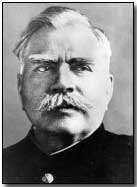Encyclopedia - The 2nd Inter-Allied Conference at Chantilly, 6 December 1915
 Convened on 6 December 1915 the inter-allied
conference at Chantilly, Paris, signalled the first concerted attempt to forge a
common Allied strategy across multiple fronts of the war. In attendance
were representatives from Britain, France, Italy, Serbia and Russia (although
the attending British Commander-in-Chief,
Sir John French, was soon to be
recalled and replaced by Sir Douglas Haig).
Convened on 6 December 1915 the inter-allied
conference at Chantilly, Paris, signalled the first concerted attempt to forge a
common Allied strategy across multiple fronts of the war. In attendance
were representatives from Britain, France, Italy, Serbia and Russia (although
the attending British Commander-in-Chief,
Sir John French, was soon to be
recalled and replaced by Sir Douglas Haig).
Attendees at the conference were presented with a memorandum suggesting inter-allied co-operation by the French.
Presided over by French Commander-in-Chief Joseph Joffre, the conference was held just two days after an Anglo-French meeting at Calais in which the British, led by war minister Lord Kitchener, succeeded in persuading the reluctant French, represented by Prime Minister Aristide Briand, to abandon Allied operations in the military and strategic backwater of Salonika.
Such was the French public and political outcry at the prospect of abandoning Salonika that Joffre seized the opportunity at Chantilly to reverse his earlier agreement with the British. The latter, keen not to unbalance Briand's administration, reluctantly agreed to continue the Salonika offensive.
Separately the Russian government, as represented by Yakov Zhilinski, argued forcefully for the principle of inter-allied co-operation during major offensives. He cited the example of the lack of coordinated Allied support during that year's Triple Offensive. Agreement was consequently reached whereby the other Allied nations would launch offensives of their own whenever any other Allied nation came under clear threat.
This was subsequently put to the test when the German Army launched a ferocious offensive upon the French fortress of Verdun the following February, resulting in the belated British Somme Offensive in July 1916 and the disastrous Russian attack at Lake Naroch in March (an ironic situation for the Russians given it was their insistence upon the policy which necessitated their own subsequent intervention).
The Italians also assisted by launching the latest in a string of offensives along the Isonzo in early March (the fifth, which as usual ended in failure).
Stormtroopers comprised specially trained German assault troops used in 1918.
- Did you know?
